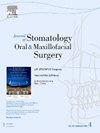网络药理学和体外实验揭示了宁波黄芩(Scrophularia ningpoensis Hemsl)治疗母细胞瘤的潜在疗效。
IF 1.8
3区 医学
Q2 DENTISTRY, ORAL SURGERY & MEDICINE
Journal of Stomatology Oral and Maxillofacial Surgery
Pub Date : 2024-11-15
DOI:10.1016/j.jormas.2024.102146
引用次数: 0
摘要
目的:本研究旨在通过网络药理学方法、生物信息学基因分析和体外细胞实验,探讨宁波黄芩(Scrophularia ningpoensis Hemsl,SNH)中对骨髓母细胞瘤(ameloblastoma,AM)具有潜在作用的有效成分:方法:从《中药系统药理学》(TCMSP)和 SwissTargetPrediction 中确定 SNH 的有效成分及其相应靶点。从GeneCards和DisGeNET数据库中筛选出AM的疾病靶点。通过生物信息学分析,利用基因表达总库(GEO)数据集 GSE38494 确定了 AM 的差异表达基因(DEGs),并进行了基因本体富集分析。利用 STRING 数据库平台生成蛋白质-蛋白质相互作用网络图,然后使用 Cytoscape 软件进行枢纽基因分析。使用 AutoDock Vina 软件对活性成分对潜在核心靶点的影响进行分子对接验证。此外,还利用 AM 细胞株 AM-1 进行了 SNH 提取物处理后的体外实验,包括定量反转录聚合酶链反应(RT-qPCR)、EdU 检测和 CCK-8 细胞增殖检测:研究结果表明,SNH 含有八种有效成分,共有 388 个药物靶点,其中包括 AM 的 10 个潜在核心靶点。分析发现的枢纽基因包括 CCNA2、HRAS、PTGS2、PIK3CB、FGFR1、CASP3、MMP1、SLC2A1、MMP14 和 MME。分子对接分析表明,主要活性成分(β-谷甾醇、山榄香甙 A_qt、山榄香甙 D、山榄香甙 D_qt 和杉醇)与靶蛋白(CASP3、FGFR1、HRAS、PTGS2 和 SLC2A1)之间具有很强的结合活性。基因本体富集分析表明,SNH 通过与细胞对非生物刺激的反应、细胞对缺氧的反应和外肽酶活性相关的途径对 AM 发挥作用。利用组织芯片进行的免疫组化分析表明,与齿状囊肿相比,AM 中 MMP14 和 PTGS2 的表达量更高。利用 AM-1 细胞系,RT-qPCR 结果证实 SNH 在 mRNA 水平上抑制了 MMP14 和 PTGS2 的表达。此外,EdUassay 和 CCK-8 检测表明 SNH 对这些细胞的增殖有抑制作用:这些研究结果表明,SNH 可抑制 MMP14 和 PTGS2 的表达,抑制 AM 的增殖。我们的研究强调了SNH作为AM治疗候选药物的潜力,这可能为临床治疗提供更多选择。本文章由计算机程序翻译,如有差异,请以英文原文为准。
Network pharmacology and in vitro experiments reveal the potential therapeutic effects of Scrophularia ningpoensis Hemsl in the treatment of ameloblastoma
Purpose
This study aimed to explore active ingredients in Scrophularia ningpoensis Hemsl (SNH) with potential effects on ameloblastoma (AM) using network pharmacological approach, bioinformatic gene analysis and in vitro cell experiments.
Methods
The active ingredients and their corresponding targets of SNH were identified from the Traditional Chinese Medicine Systems Pharmacology (TCMSP), as well as SwissTargetPrediction. Disease targets of AM were selected from GeneCards and DisGeNET databases. Differentially expressed genes (DEGs) of AM were identified, and Gene Ontology enrichment analysis were performed using the Gene Expression Omnibus (GEO) dataset GSE38494 through bioinformatic analysis. The STRING database platform was utilized to generate a protein–protein interaction network diagram, followed by hub gene analysis using Cytoscape software. AutoDock Vina software was used to perform molecular docking verification of the effects of the active ingredients on potential core targets. Additionally, in vitro experiments including quantitative reverse transcription polymerase chain reaction (RT-qPCR), EdU assay and CCK-8 cell proliferation assay were conducted using AM cell line AM-1 after SNH extract treatment.
Result
The study revealed that SNH contains eight active ingredients and a total of 388 drug targets, including 10 potential core targets in AM. Hub genes identified in the analysis were CCNA2, HRAS, PTGS2, PIK3CB, FGFR1, CASP3, MMP1, SLC2A1, MMP14, and MME. Molecular docking analysis demonstrated strong binding activity between key active ingredients (β-sitosterol, scropolioside A_qt, scropolioside D, scropolioside D_qt, and sugiol) and target genes (CASP3, FGFR1, HRAS, PTGS2, and SLC2A1). Gene Ontology enrichment analysis indicated that SNH exerts its effects on AM through pathways related to cellular response to abiotic stimulus, cellular response to hypoxia, and exopeptidase activity. Immunohistochemical analysis using tissue microarray showed higher expression of MMP14 and PTGS2 in AM compared to dentigerous cyst. Using AM-1 cell line, RT-qPCR results confirmed that SNH suppressed the expression of MMP14 and PTGS2 at mRNA level. Additionally, the EdUassay and CCK-8 assay indicated the inhibitory effect of SNH on the proliferation of AM-1 cells.
Conclusion
These findings showed that SNH could suppress expression of MMP14 and PTGS2 and restrain the proliferation of AM. Our study highlights the potential of SNH as a promising therapeutic candidate for AM, which may provide more options for clinical treatment.
求助全文
通过发布文献求助,成功后即可免费获取论文全文。
去求助
来源期刊

Journal of Stomatology Oral and Maxillofacial Surgery
Surgery, Dentistry, Oral Surgery and Medicine, Otorhinolaryngology and Facial Plastic Surgery
CiteScore
2.30
自引率
9.10%
发文量
0
审稿时长
23 days
 求助内容:
求助内容: 应助结果提醒方式:
应助结果提醒方式:


